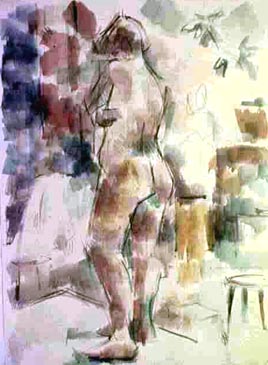COURSE SYLLABUS - LIFE DRAWING Art 350 MWF 2:00 - 4:50 PM
Instructor: Barbara Branham
I. COURSE DESCRIPTION AND GOALS:
The class meets three times a week, for 3 hours per session, to draw from a nude model. The instructor is present for two sessions to give lectures, demonstrations and assistance to students. The third session is required practice time. There will be a model and an attendance sheet.
The class is designed to continue over three quarters. Fall quarter gives emphasis to the skeletal structure of the body, winter quarter to the muscular system and spring quarter to consolidating the information of the previous two quarters as well as to composition and expressive means. In addition to these concerns various approaches to drawing are discussed/demonstrated during each quarter.
The goals of this sequence of study are to give the student a basic grounding in human anatomy as a platform to understanding the proportions and dynamics of the body and to demonstrate the power of the human form as an expressive vehicle.
Emphasis for the beginner is on developing the ability to see and state as economically and accurately as possible the essential aspects of the figure. Through the use of gesture and brief poses, the ability to do this quickly is also emphasized. The skeletal system is studied in some detail the first quarter in order to provide the basis for human proportion as well as the knowledge to see the bony influences of the skeleton on the surface of the living figure. Students concentrate on the use of line as a means of description and expression.
During the second quarter the muscular system is studied. The student learns how the masses of the body are affected by the action of the body. The effective use of light and dark to convincingly convey form is another goal.
The third quarter is intended to be a period of consolidating information gained in the previous two quarters. Since, it is hoped that the student will have gained some mastery of the figure by this time, there is greater emphasis on composition, the figure in an environment, and compositional and psychological elements of using more than one figure in a composition.
II. TEXTBOOK
No specific text is required. Buying a good anatomy book or xeroxing anatomy drawings from library reference material is strongly recommended. A number of good paperback texts are available, among them:
The Atlas of Human Anatomy by Stephen Rogers Peck
Figure Drawing by Nathan Goldstein
Master Class in Figure Drawing by Robert Beverly Hale
Artistic Anatomy by Dr. Paul Richer
III. EVALUATION AND GRADES:
Criticism is given on a fairly informal basis during class sessions. Occasionally work may be put up on the board for review but most discussion takes place during class with individual students.
Course grades are based on a portfolio of work selected from class work, sketchbook assignments and, in Fall and Winter quarters, a short exam. This portfolio will be turned in at the end of the quarter, usually a couple of days before the scheduled exam date. It is important that the student save and date all work done in class.
Criteria for grades:
A superior work and effort; good grasp of basic drawing skills and human proportion and
and structure; high degree of consistency of quality work; good attendance
B above average work and effort; majority of work of consistent quality; good attendance
C average work and effort; good attendance
D below average
IV. EXPECTATIONS FOR STUDENTS:
Class attendance is extremely important. The process of learning to draw and particularly the skills needed to draw the human figure require a lot of practice! Missed classes are difficult to make up. The student's responsibility is to be in class on time and prepared to work for the duration of the class. Missed classes should be made up (see instructor about alternatives). If a student finds that personal circumstances or an emergency will result in more than 3 absences he/she should discuss options with the instructor at the earliest possible opportunity.
The model is to be treated with courtesy and respect. Visitors are not allowed in the classroom once class has begun.
V. IMPORTANT DATES (Winter 1997)
Jan. 5 Classes begin (Monday) (85% refund begins)
Mar. 8 Last day of class (sketchbooks are due)
Mar. 10 Make up day -- model will be scheduled.
March 13 Monday, portfolios turned in no later than 10:30 am in Rm. 227 (life drawing rm.)
March 15 exam and portfolios returned -- Wednesday, March 17, 12:30pm.
"We see nothing truly until we understand it." John Constable
"A would-be artist may have the most profound visions, feelings and insights, but without skill there is no art."
Stephen Nachmanovitch

